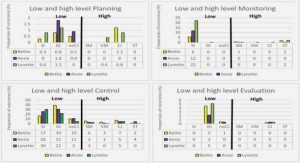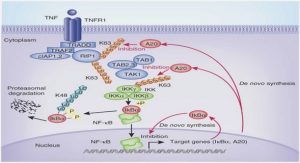Get Complete Project Material File(s) Now! »
Chapter 3 Dynamical Responses in Composite Multiferroics
Introduction
From 19th century, the Maxwell’s equations perfectly described how magnetic and electric fields are generated by charges, currents and changes of each other. The magnetism and elec-tricity were thus combined into one discipline. However, with advancements in technology, the magnetic and electric orderings in condensed matter physics are often being considered separately. Electrons and ions are responsible for electric charge effects, whereas electron spins govern magnetic properties [38].
Magnetoelectric Effect
Generally, magnetic properties in usual materials are affected by magnetic fields, and dielec-tric properties are by electric fields. In contrast, the magnetoelectric effect is the phenomenon for describing the cross-linking dependence of the magnetization and electric polarization, on external electric and magnetic fields, respectively.
The birth of the magnetoelectric effect can be tracked back to two independent events: In 1888, Wilhelm C. Röntgen placed a moving dielectric in an electric field, and he observed the dielectric been magnetized [39]; In 1894, Pierre Curie proposed that the symmetry consideration has the possibility on cross-linking magnetic and electric behaviors in materials [40]. A few years later, the polarization has been observed in a moving dielectric via a magnetic field, by Harold A. Wilson in 1905 [41]. This work thus started to attract people’s interest. The term ‘magnetoelectric ’ was named by P. Debye in 1926 [42]. While until 1959, the form of the magnetoelectric coupling was derived in antiferromagnetic Cr2O3 by I. Dzyaloshinskii [43] and D. Astrov experimentally confirmed this effect in one later [44]. Recently, theoretical and technological progresses triggered a renaissance of the magnetoelectric effect is still heavily investigated.
The magnetoelectric effect can be traditionally expressed with respect to the external fields in the Landau theory [38]. The Landau free energy F represents the magnetoelectric interaction, can be writing in terms of an electric field E and a magnetic field H [45.
where Pi and Mi denote the spontaneous electric polarization and magnetization, whereas ε0 and µ0 denote the permittivity and permeability of free space. Second-rank tensors εi, j and µi, j are the relative permittivity and permeability, respectively. The tensor gi, j is the linear magnetoelectric coupling, which corresponds to the induction of electric polarization by a magnetic field or magnetization by an electric field. Third-rank tensors αi, j,k and βi, j,k are the quadratic magnetoelectric coefficients. The differentiation of the free energy leads to the electric polarization Pi.
Multiferroics
Multiferroics are materials having at least two primary ferroic orders (i.e., ferromagnetism, ferroelectricity, or ferroelasticity) coexisting in the same phase [46]. Such as ferromag-netic ferroelastics, ferroelectric ferroelastics, and ferromagnetic ferroelectrics are formally multiferroics. Typically, the term ‘multiferroics’ has been commonly understood as the magnetic and electric properties combined in single phase materials. This kind of materials have persistent coupling between the magnetic and electric moments, due to their solid crystallographic structures, and most of them are transition metal oxides with a perovskite crystal structure [47]. Multiferroics can be generally divided into two classes as introduced by D. Khomskii: Type-I and type-II multiferroics [38]. The former is “old” multiferroics, such as BiFeO3, BiMnO3, PbVO3 and YMnO3. In these materials, ferroelectricity appears at higher temperatures than magnetism. Unfortunately, the coupling between magnetism and ferroelectricity in type-I multiferroics is usually rather weak. The type-II multiferroics, such as TbMnO3, MnWO4 and HoMn2O5 have strong magnetoelectric coupling. But the ferro-electricity appears in conjunction with a spin-spiral magnetic phase at very low temperatures [47].
However, it is difficult to find a multiferroic material with large magnetoelectric coupling in the room temperature. Because of the ferromagnetism and ferroelectricity have different criteria to be fulfilled. In general, ferroelectric materials are insulators, which have not any free carries (i.e., empty d-shells) [48]. In contrast, ferromagnets are usually metals, where electrons are partially filled d-shells to produce the magnetic orders [49]. In other words, broken time-reversal symmetry needs to be satisfied in the case of ferromagnets, whereas broken space-reversal symmetry in the case of ferroelectrics [50].
Composite Multiferroics
Natural multiferroics are rare compounds, their magnetoelectric responses are relatively weak and require low temperatures [51]. Hence, they are difficult to apply in technological appli-cations. In contrast, composite multiferroics, incorporating ferromagnets and ferroelectrics, can generate a strong response of the magnetoelectric effect above the room temperature. Ferromagnetic materials are normal magnetic metals (e.g., iron, cobalt, nickel, and their oxides), whereas the ferroelectrics are, for instance, BaTiO3, PbTiO3, and piezoelectric ceramics (e.g., lead zirconate titanate). So far, composite multiferroics have received much attention and are being studied extensively within applications, such as microwave devices, tunnel magnetoresistance sensors, transducers, spin valves, and multiple state memory elements. The magnetoelectric mechanism of the composite ferromagnetic/ferroelectric multiferroics is known as results from the elastic coupling between the magnetostrictive (magnetic-mechanical) effect in the ferromagnetic phase and the piezoelectric (electrical-mechanical) effect. Figure 3.1 shows a sketch of magnetically induced electric polarization. In ferromagnets, the variation of the magnetization produced by an applied magnetic field induces magnetostrictive strain until reaching its saturation value. This strain acts on coupled ferroelectrics as a stress and resulting in the piezoelectric effect producing a net polarization. Consequently, a series of magnetic-mechanical-electrical effects constitute the magnetoelec-tric effect, which emphasizes the influence of magnetic fields on electric polarizations [52]. In contrast, a magnetization is induced by an electric field is called converse magnetoelectric effect, also can be understood by strain-stress effects.
The aim of this chapter is to invesgate the field-driven behaviors in composite mul-tiferroics by using the magnetic spin model [Chapter 1] and the electric pseudospin model[Chapter 2]. The magnetoelectric coupling links magnetic spins and electric pseu-dospins at the interface, which supports the energy transfer from the driving part to the driven part. Here, we construct four composite models such as a one-dimensional chain [Section 3.2], one-dimensional ladder [Section 3.3], two-dimensional thin film [Section 3.4], and two-dimensional thin film with twisted boundary conditions [Section 3.5].
1D Composite Chain Model
In this section, we show observations of magnetoelectric effects in a composite multiferroic model by applying either electric or magnetic field. For this purpose, we consider a one-dimensional (1D) composite ferromagnetic/ferroelectric chain, consisting of numbers of magnetic spins and electric pseudospins. This chain is connected by the magnetoelectric coupling between the last magnetic spin and the first electric pseudospin. Figure 3.2 shows the schematic visualization of the chain, and its effective Hamiltonian is shown in Section 3.2.1. Numerical results present different responses in the ferromagnetic and ferroelectric parts [Section 3.2.2]. Additionally, the thermal agitation has been considered by adding a Gaussian white noise in simulations [Section 3.2.3]. We use a stochastic standard deviation to control the influence of temperature.
1 Magnetic Spins and their Dynamics
1.1 Introduction
1.2 Classical Heisenberg Model
1.3 Spin Dynamics Simulation
2 Electric Pseudospins and their Dynamics
2.1 Introduction
2.2 Transverse Ising Model
2.3 Pseudospin Dynamics
3 Dynamical Responses in Composite Multiferroics
3.1 Introduction
3.2 1D Composite Chain Model
3.3 1D Composite Ladder Model
3.4 2D Composite Thin Film Model with Monte Carlo Simulation
3.5 2D Composite Thin Film Model with Twisted Boundaries
3.6 Conclusions
4 Magnetoelectric Skyrmions in Composite Systems
4.1 Introduction
4.2 Electrically Induced Magnetic Skyrmions
4.3 Electric ‘Skyrmions’
4.4 Conclusions
5 Mechanical Methods of the Skyrmion Transport
5.1 Introduction
5.2 Mechanically Moving the ferroelectric Layer
5.3 Mechanically Moving the Electric Field
5.4 Conclusions
GET THE COMPLETE PROJECT
Composite Multiferroics and Magnetoelectric Skyrmions




